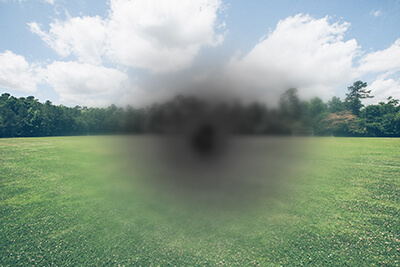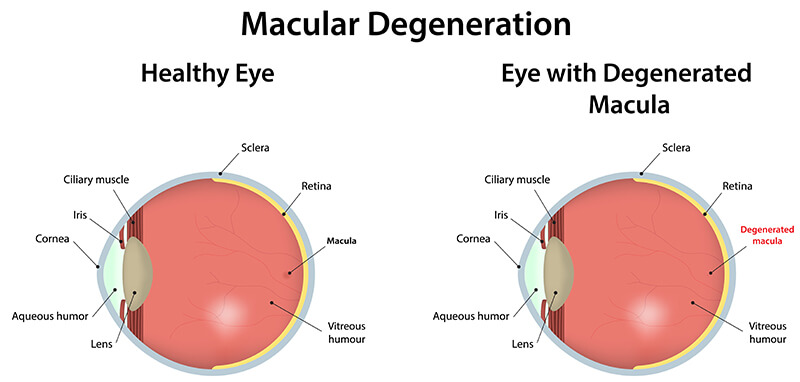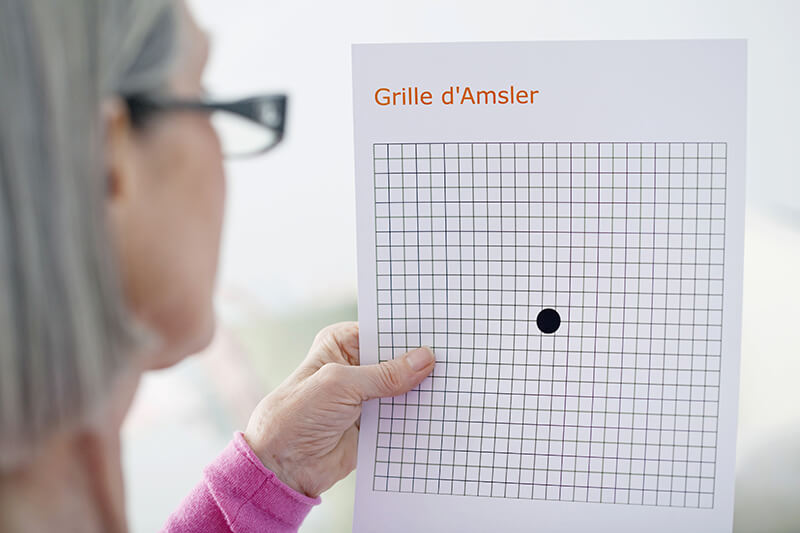Macular Degeneration
What Is Macular Degeneration?

Macular degeneration is a deterioration or breakdown of the macula. The macula is a small area in the retina at the back of the eye that allows you to see fine details clearly and perform activities such as reading and driving. When the macula does not function correctly, your central vision can be affected by blurriness, dark areas or distortion. Macular degeneration affects your ability to see near and far, and can make some activities like threading a needle or reading difficult or impossible.
Although macular degeneration reduces vision in the central part of the retina, it does not affect the eye’s side, or peripheral, vision. For example, you could see the outline of a clock but not be able to tell what time it is.
Macular degeneration alone does not result in total blindness. Even in more advanced cases, people continue to have some useful vision and are often able to take care of themselves. In many cases, macular degeneration’s impact on your vision can be minimal.

What Causes Macular Degeneration?
Many older people develop macular degeneration as part of the body’s natural aging process. There are different kinds of macular problems, but the most common is age-related macular degeneration (AMD). Exactly why it develops is not known, and no treatment has been uniformly effective. Macular degeneration is the leading cause of severe vision loss in Caucasians over 65.
Two Most Common Types of AMD:
Normal Macula
In the normal macula, nutrients are able to pass from the network of blood vessels underneath the retina (choroid) into the retina. Waste products from retinal metabolism are able to pass easily out of the retina and be carried away by the blood vessels of the choroid.
Dry Macular Degeneration – (atrophic)
As aging occurs, so does the most common form of AMD, the “dry” form. In dry AMD, waste products from retinal cells are deposited in the retinal tissues below the retina. These waste products appear to the ophthalmologist as yellowish deposits called drusen. These waste products block nutrients from the underlying blood vessels (choroid) from reaching the metabolically active retinal cells. In this condition, visual loss is very gradual.
Wet Macular Degeneration – (exudative)
The “wet” form of macular degeneration accounts for about 10 percent of all AMD cases. It results when abnormal blood vessels form underneath the retina at the back of the eye. These new blood vessels leak fluid or blood and blur central vision. Vision loss may be rapid and severe.
What Are the Symptoms of Macular Degeneration?
Macular degeneration can cause different symptoms in different people. The condition may be hardly noticeable in its early stages. Sometimes only one eye loses vision while the other eye continues to see well for many years.
But when both eyes are affected, the loss of central vision may be noticed more quickly.
Following are some common ways vision loss is detected:
- words on a page look blurred;
- a dark or empty area appears in the center of vision;
- straight lines look distorted, as when looking at an “Amsler Grid.”
How Is Macular Degeneration Diagnosed?
Many people do not realize that they have a macular problem until blurred vision becomes obvious. Your ophthalmologist can detect early stages of AMD during a medical eye examination that includes the following:
- A simple vision test in which you look at a chart that resembles graph paper called an “Amsler Grid” – there is one down further on this page.
- Viewing the macula with an ophthalmoscope
- Taking special photographs of the eye called fluorescein angiographs to find abnormal blood vessels under the retina.
How Is Macular Degeneration Treated?
Anti-angiogenic drugs. Dr. Tokuhara injects medications into your eye. They stop new blood vessels from forming and block leaking from abnormal vessels that cause wet macular degeneration. This is an in-office procedure that takes a few minutes. Treatments are usually repeated for several weeks or months.
Nutritional Supplements
Although the exact causes of macular degeneration are not fully understood, antioxidant vitamins and zinc may reduce the impact of AMD in some people.
A large scientific study found that people at risk for developing advanced stages of AMD lowered their risk by about 25 percent when treated with a high-dose combination of vitamin C, vitamin E, beta carotene and zinc. Among those who have either no AMD or very early AMD, the supplements did not appear to provide an apparent benefit.
Deposits under the retina called “drusen” are a common feature of macular degeneration. Drusen alone usually do not cause vision loss, but when they increase in size or number, this generally indicates an increased risk of developing advanced AMD. People at risk for developing advanced AMD have significant drusen, prominent dry AMD, or abnormal blood vessels under the macula in one eye (“wet” form).
It is very important to remember that vitamin supplements are not a cure for AMD, nor will they restore vision that you may have already lost from the disease. However, specific amounts of these supplements do play a key role in helping some people at high risk for advanced AMD to maintain their vision. You should speak with your ophthalmologist to determine if you are at risk for developing advanced AMD, and to learn if supplements are recommended for you.
Despite advanced medical treatment, many people with macular degeneration still experience some vision loss.
To help you adapt to lower vision levels, your ophthalmologist can prescribe optical devices or refer you to a low-vision specialist or center. A wide range of support services and rehabilitation programs are also available to help people with macular degeneration maintain a satisfying lifestyle.
Because side vision is usually not affected, a person’s remaining sight is very useful. Often, people can continue with many of their favorite activities by using low-vision optical devices such as magnifying devices, closed-circuit television, large-print reading materials, and talking or computerized devices.
Testing Your Vision With the Amsler Grid

You can check your own vision daily by using an Amsler grid. You may find changes in your vision that you wouldn’t notice otherwise. Putting the grid on the front of your refrigerator is a good way to remember to look at it each day.
To use your Amsler grid:
- Wear your reading glasses and hold this grid 12 to 15 inches away from your face in good light.
- Cover one eye.
- Look directly at the center dot with the uncovered eye.
- While looking directly at the center dot, note whether all lines of the grid are straight or if any areas are distorted, blurred or dark.
- Repeat this procedure with the other eye.
- If any area of the grid looks wavy, blurred or dark, call our office.

